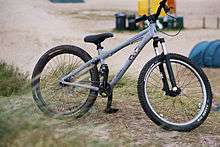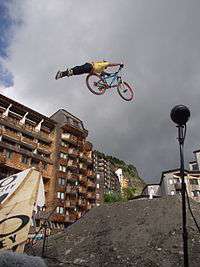Dirt jumping

Dirt jumping is one of the names given to the practice of riding bikes over cement type jumps of dirt or soil and becoming airborne. The idea is that after riding over the 'take off' the rider will become momentarily airborne, and aim to land on the 'landing'.
Dirt jumping can be done on almost any vehicle with wheels, but it is usually executed on a dirt jump bike.
- BMX bike built for dirt jumping tends to have a longer top tube than a street BMX bike, and may well be more reinforced. They will rarely have pegs fitted, and will generally run only a rear v-brake. Also, the tires will be treaded, as opposed to the slicks and semi-slicks used for park riding. Large, padded seats are also popular for a smoother landing if the jump is not done properly and are also easier to hold for in-flight tricks; However some riders do not find seat size an issue. The gear ratio is generally around 44:16, 36:13, 33:12, 30:11 or 25:9 though using small gearings such as 25:9, known as 'micro gearing', has become popular.
- Hybrid BMX/Jump bike - a scaled-up BMX with 24-inch wheels. Strong alloy rims and lightweight chromoly frame. Suited to bigger jumps or more challenging competition courses.
- Freestyle Motocross (FMX, Moto-X) of various sizes & engine sizes.

- Dirt Jump/Freestyle mountain bikes look similar to mountain bikes but usually have a rigid frame and, a lower stand-over height, this keeps the seat out of the way while performing tricks. Some high end DJ frames also have short travel rear suspension, sometimes with bottom-bracket-concentric pivots to allow singlespeed use. The wheels are usually more robust than a cross country mountain bike's and the same for the frame.
- Mountain bikes - 24- or 26-inch wheels and either rigid forks or forks with short front end suspension (usually 80–100 mm travel, but can be up to 203 mm depending on the type of the bicycle) Firm suspension is desirable for dirt jumping.
A mountain bike built for dirt jumping tends to have a smaller frame than what is used for other disciplines. Running singlespeed with one brake is very common. using single or dual disc brakes has replaced the use of only one rear V-brake. In general, a mountain bike dedicated to dirt jumping will have 24- or 26-inch wheels, a gear ratio of approximately 60 gear inches (~36:15 on a 24-inch rear wheel or ~36:16 on a 26-inch rear wheel) and rigid or 80-100mm travel forks. An 'all-round' bike used for dirt jumping will more likely have 26-inch wheels, a 25-36 tooth chainring with a wide-ratio cassette and a short- to mid-travel fork. Mountain bike dirt jumpers are usually split on the basis of wheel size because the wheel size dictates the shape of the takeoff to an extent. Dirt Jump bikes are made by a variety of companies.
A 20-inch BMX bike for dirt generally has a 48-spoke rear rim and a 36-spoke front to prevent rim collapse in the case of casing a jump. the frame is a little bit longer to aid in more stability and to spread the load of heavy lands. most of these "micro geared" bike run 85 to 100 psi tires. these are usually threaded and made with kevlar bead to prevent pressure flats and tears.
History
Dirt Jumping evolved alongside BMX racing from its birth. Dirt Jumping is similar to BMX or Mountain bike racing in that the rider jumps off of mounds of dirt. It differs in that the jumps are usually much larger and designed to lift the rider higher into the air. Additionally, the goal is not to complete the course with the fastest time, but rather to perform the best tricks with the best style. Trails are most often hand built, with attention to detail. Dirt jumping has evolved to crash now, there are now competitions that you can compete in for prizes. The dirt jumps have become much larger and better built. They now use diggers and other machines to help build and compact the dirt quicker and more efficiently. The dirt jumps which are sometimes even built with wood can even be up to between 20 and 30 feet long for the professionals. The tricks have evolved a lot partly due to freestyle motocross evolving where a lot of the dirt jumpers get their inspiration from. When it first started it would be just tabletops and whips as the main tricks, now nearly every professional can back flip, front flip and even double back flip.
Types of jumps

- Double the most common form of Dirt jumps. This consists of two separate earthworks, one acting as a takeoff (lip), and the other as a landing. Also known as a "gap" jump. They can be "Step-Ups", where the jump's up ramp is lower than the down ramp and the rider loses speed, or "Step-Downs", where the jump's down ramp is lower than the up ramp, meaning that they gain speed.
- Tabletops are more common among those new to the sport, they are a single earthwork with a takeoff at one end, and a landing at the other, with a flat 'table' on the top. These are favoured by new riders because when the rider comes up short they can still easily ride out of it.
- Ski Jumps consist of just a takeoff, they're usually longer and flatter than other jumps, and tend to be situated on downhills, so the slope of the hill can serve as a landing. They're used mostly in competitions on jump length.
- Rollers are small tabletops that give you extra speed by 'pumping' the jump. They are usually found at the beginning of a trail.
- Step ups are ramps just before inclines. They enable riders to jump from the top of the incline to a raised landing.
- Whoops/Rhythms a series of three or more small rounded ramps close together, enabling riders to 'manual' over them.
- Spine is a steep dirt jump with a take-off and a landing, but no table or gap, made to get higher air without distance.
- Berm a curved wallride that comes out of the ground. Mostly used on sharp turns, berms assist riders by giving them the ability to ride horizontally. The curve allows riders to make a sharper turn. Mainly used on downhill trails, but can also be present alongside dirt jumps to help riders avoid hitting trees. They are also used to maintain riders' speed without having to brake on turns. Some trails consist of jumps that lead into berms.
- Hip Jumps consist of a jump with the landing 45 - 90 degrees left or right of the ramp, enabling transfers.
- Triple Jumps consist of a take off, unused earthwork and a landing
- 360 Berms consist of a large berm that goes just shy of 360 degrees, and is either jumped into and/or out of.
Types of Acrobatics
| Name | Description |
|---|---|
| Tsunami Flip | While in the air, the bike is flipped behind the rider initially, with the rider remaining stationary, the rider then tucks backwards, rotating 360° onto the pedals. |
| Tire grab | While in the air, the rider grabs his/hers front tire |
| Tabletop | While in the air tipping the bike on its side to a 90° angle or further. |
| Euro Table | Sometimes called a Dark side, a euro table is when you turn your handlebars downwards instead of upwards as you would in a table. |
| Invert | Essentially a table, but over extended. possibly enough for the front tire or fork to rub on your shoulder. |
| Unturndown | Similar to an Invert, but the riders legs remain straight and the seat tend to wrap around the riders outside leg. |
| Whip | Keeping the front of your bike straight while flicking the back to one side. There are many different styles of whips, each depending on the style of the rider. |
| ET | Pedaling forwards, one full rotation in the air |
| Autistic Air | Et and do a 2-star at the same time. |
| Cannonball | Taking both feet off the pedals and grabbing the seat with both hands |
| Tuck No Hander | Both hands off the handlebars with your legs pinching top tube and your bars in your lap. |
| Suicide No hander | Hands behind back while in the air with legs pinching seat. |
| Toboggan | One hand off handlebars touching the seat or top tube, one hand turning bars 90°. Tilt front down for extra style. |
| No footer | Both feet off pedals. |
| One foot can | One foot taken off and put over top tube to the other side of bike |
| No-footed Can-can | Similar to one foot can except done on both sides so that both legs are together, off the pedals and on the same side of the top tube |
| Nac-Nac | Similar to the One foot can, except your leg goes behind your other one still on the pedal, instead of in front. |
| Backflip | Rotating bike and rider completely upside down & continuing to rotate 360° of vertical rotation until facing original angle/direction. Can also be performed twice (while still in the air) to make a double back flip. |
| 360 | Rotating the bike and rider completely round 360° horizontally until facing original direction. |
| Front flip | Inverse of a back flip |
| X-up | Turning the bars 180° or further without releasing the handle bars to make the riders arms form an X shape |
| Barspin | Using one hand to guide the handlebar around one full rotation (360 Degrees). |
| Tail Whip | Kicking the bike while holding the handlebars so that the frame makes a 360 degree rotation while the rider does not rotate |
| Turndown | Similar to an x-up but the entire body turns with the bars and the bike frame is as vertical as possible. Variation on the "cross-up" which incorporates elements of both the "Table" and X-up. |
| Superman | No footer with feet extended out to the back, in a Superman position.  Superman |
| Superman Seatgrab | A standard superman but with one hand on the seat rather than the handlebars |
| Nothing | Nothing is touching the bike, neither arms nor legs, hence the name. |
| Superflip | Superman while backflipping. |
| 2-Star | Forming a semi-star with one hand, and one foot (Usually opposites) |
| 3-Star | Only one hand touches the handlebars, so the extended arm and legs form a star. |
| Dangler | Only one foot on one pedal with both hands taken off the bars, a variation of the "3-star" |
| Mays | When in mid-Air the universal audio symbol is made with the hands and feet. |
| Backflip Tailwhip (Flipwhip) | As the name suggests, doing a tailwhip whilst upside down (halfway through) a backflip. |
| Flair | Invented by Mat Hoffman, more commonly a bmx trick, this can be also be done on a mountain bike. It involves getting substantial air off a vert ramp, then doing a backflip and 180 so that you roll down the ramp going back the way you came. |
| Truck Driver | Doing a 360 and barspin combination, when the bars spin in the opposite direction of the 360. |
| Decade | Like a barspin, but person wraps around with the bars in a 360° position while tail stays straight. |
| Orbital 360 | Like a regular 360, but the rider dips the front of the bike down so that both the rider and the bike are vertical during the rotation, the end of the rotation generally feels and looks a bit like a backflip. |
| California Roll | Invented by Mike Montgomery, this is where the rider does a 360 around his bike, it is similar to a body varial however the rider does not touch the bike during the rotation. |
| Cliff Hanger Backflip | Invented by Mike Montgomery, this is where the rider does a no hander but holds on the handlebars with their feet, while in a rotation of a backflip. |
| Flip Double whip | Invented by Greg Watts, this is where the rider does a back flip and two tail whips whilst in the air . |
| Truck Driver Tailwhip | Invented by Martin Soderstrom, this is where the rider does a Truck Driver and a tailwhip, which is when the rider does a 360 barspin to tailwhip. |
| 360 Downside Tailwhip | Invented by Tyler Mccaul, this is where the rider does a 360 and a tailwhip in the opposite direction. |
| Special Flip | Invented by "Special" Greg Powell from Nitro Circus. This is where the rider performs a backflip while the bike stays flat. |
| Cashroll | Consists of doing a 180 into a corked backflip, into another 180 in the same rotation. |